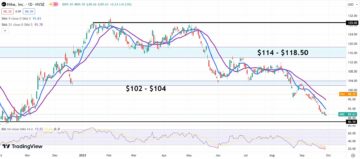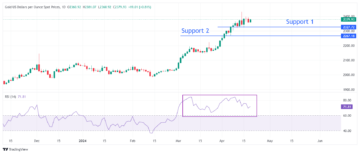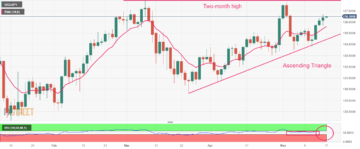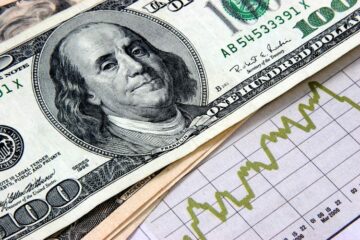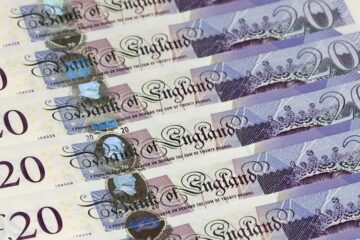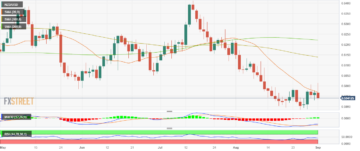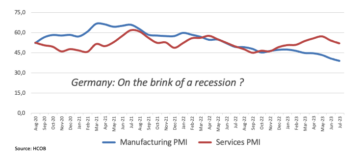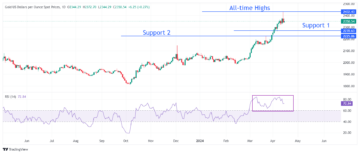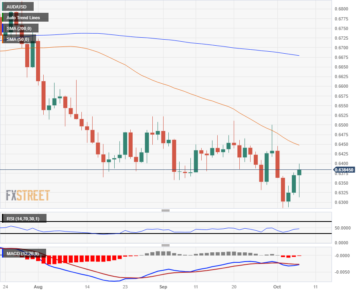
- Gold price remains well supported by bets for an imminent Fed rate cut later this year.
- The prevalent risk-on environment keeps a lid on any further gains for the XAU/USD.
- Thursday’s sustained breakout through the $2,040-2,042 hurdle favours bullish traders.
Gold price (XAU/USD) holds steady around the $2,045 region during the Asian session on Friday and remains well within the striking distance of a nearly one-month peak touched the previous day. The US Personal Consumption Expenditures (PCE) Price Index released on Thursday showed that annual inflation in January was the lowest in three years, opening the door for an eventual interest rate cut by the Federal Reserve (Fed). This fails to assist the US Dollar (USD) to build on the overnight solid rebound from a technically significant 200-day SMA and turns out to be a key factor acting as a tailwind for the precious metal.
That said, comments by a slew of influential FOMC members suggest that the US central bank was in no hurry to cut interest rates. Moreover, investors seem convinced that the Fed will wait until the June policy meeting before lowering borrowing costs. This, in turn, remains supportive of elevated US Treasury bond yields and caps the upside for the non-yielding Gold price. Apart from this, the prevalent strong bullish sentiment across the global equity markets is seen as another factor holding back traders from placing fresh bullish bets around the safe-haven XAU/USD, warranting caution before positioning for further gains.
Daily Digest Market Movers: Gold price lacks follow-through buying amid Fed’s hawkish outlook
- The US inflation data came in line with market expectations, suggesting that the Federal Reserve is going to stay on track to cut interest rates later this year and lending some support to the Gold price.
- The Core US PCE Price Index – the Fed’s preferred inflation gauge that excludes food and energy prices – climbed 0.4% in January and the yearly rate eased to 2.4% from 2.6% in the previous month.
- Meanwhile, the CME Group’s FedWatch Tool indicates that markets are still pricing in the possibility of the first interest rate cut in June and the bets were reaffirmed by comments by several Fed officials.
- Atlanta Fed President Raphael Bostic said that the speed at which US inflation is easing means it will likely be appropriate for the US central bank to start cutting interest rates during the summertime.
- San Francisco Fed President Mary Daly said central bank officials are ready to lower interest rates as needed but emphasized there is no urgent need to do so given the strength of the US economy.
- Cleveland Fed President Loretta Mester said the recent inflation data suggests that policymakers have more work to do to cool price pressures but didn’t change her view for three rate cuts this year.
- New York Fed President John Williams reiterated that the next move for the US central bank is likely to be cut to its interest rate target, though noted there is no sense of urgency to do that.
- The US Treasury bond yields aren’t far from their recent highs, which, along with an extension of the risk-on rally across the global equity markets, keeps a lid on further gains for the safe-haven XAU/USD.
Technical analysis: Gold price bulls might aim to test the next relevant hurdle near the $2,065 area
From a technical perspective, the overnight breakout through the $2,040-2,042 horizontal resistance was seen as a fresh trigger for bullish traders. Moreover, oscillators on the daily chart have been gaining positive traction and support prospects for an extension of the recent goodish rebound from the YTD low, around the $1,984 region touched in February. Hence, a subsequent strength towards the next relevant hurdle near the $2,065 region, en route to the $2,100 round figure, looks like a distinct possibility.
On the flip side, weakness back below the $2,040-2,042 resistance-turned-support might now be seen as a buying opportunity and is more likely to find decent support near the $2,025-2,024 area, or the weekly low. This is followed by the 100-day Simple Moving Average (SMA), currently near the $2,014 region. This is followed by the $2,000 psychological mark, which if broken might shift the near-term bias in favour of bearish traders and drag the Gold price to the $1,984 support en route to the very important 200-day SMA, near the $1,969-1,968 zone.
US Dollar price today
The table below shows the percentage change of US Dollar (USD) against listed major currencies today. US Dollar was the strongest against the Japanese Yen.
| USD | EUR | GBP | CAD | AUD | JPY | NZD | CHF | |
| USD | -0.14% | -0.06% | -0.07% | -0.20% | 0.17% | -0.18% | -0.05% | |
| EUR | 0.13% | 0.07% | 0.05% | -0.06% | 0.31% | -0.05% | 0.09% | |
| GBP | 0.06% | -0.07% | -0.04% | -0.13% | 0.24% | -0.12% | 0.01% | |
| CAD | 0.09% | -0.03% | 0.04% | -0.09% | 0.28% | -0.08% | 0.04% | |
| AUD | 0.20% | 0.06% | 0.13% | 0.11% | 0.37% | 0.02% | 0.15% | |
| JPY | -0.16% | -0.31% | -0.23% | -0.26% | -0.36% | -0.34% | -0.22% | |
| NZD | 0.16% | 0.02% | 0.11% | 0.09% | -0.04% | 0.34% | 0.11% | |
| CHF | 0.04% | -0.08% | 0.00% | -0.05% | -0.13% | 0.24% | -0.12% |
The heat map shows percentage changes of major currencies against each other. The base currency is picked from the left column, while the quote currency is picked from the top row. For example, if you pick the Euro from the left column and move along the horizontal line to the Japanese Yen, the percentage change displayed in the box will represent EUR (base)/JPY (quote).
Gold FAQs
Gold has played a key role in human’s history as it has been widely used as a store of value and medium of exchange. Currently, apart from its shine and usage for jewelry, the precious metal is widely seen as a safe-haven asset, meaning that it is considered a good investment during turbulent times. Gold is also widely seen as a hedge against inflation and against depreciating currencies as it doesn’t rely on any specific issuer or government.
Central banks are the biggest Gold holders. In their aim to support their currencies in turbulent times, central banks tend to diversify their reserves and buy Gold to improve the perceived strength of the economy and the currency. High Gold reserves can be a source of trust for a country’s solvency. Central banks added 1,136 tonnes of Gold worth around $70 billion to their reserves in 2022, according to data from the World Gold Council. This is the highest yearly purchase since records began. Central banks from emerging economies such as China, India and Turkey are quickly increasing their Gold reserves.
Gold has an inverse correlation with the US Dollar and US Treasuries, which are both major reserve and safe-haven assets. When the Dollar depreciates, Gold tends to rise, enabling investors and central banks to diversify their assets in turbulent times. Gold is also inversely correlated with risk assets. A rally in the stock market tends to weaken Gold price, while sell-offs in riskier markets tend to favor the precious metal.
The price can move due to a wide range of factors. Geopolitical instability or fears of a deep recession can quickly make Gold price escalate due to its safe-haven status. As a yield-less asset, Gold tends to rise with lower interest rates, while higher cost of money usually weighs down on the yellow metal. Still, most moves depend on how the US Dollar (USD) behaves as the asset is priced in dollars (XAU/USD). A strong Dollar tends to keep the price of Gold controlled, whereas a weaker Dollar is likely to push Gold prices up.
- SEO Powered Content & PR Distribution. Get Amplified Today.
- PlatoData.Network Vertical Generative Ai. Empower Yourself. Access Here.
- PlatoAiStream. Web3 Intelligence. Knowledge Amplified. Access Here.
- PlatoESG. Carbon, CleanTech, Energy, Environment, Solar, Waste Management. Access Here.
- PlatoHealth. Biotech and Clinical Trials Intelligence. Access Here.
- Source: https://www.fxstreet.com/news/gold-price-holds-steady-just-below-one-month-peak-touched-on-thursday-202403010336
- :has
- :is
- $UP
- 000
- 1
- 100
- 2%
- 2022
- 33
- 34
- 41
- 42
- 5
- a
- According
- across
- acting
- added
- against
- aim
- along
- also
- Amid
- an
- analysis
- and
- Animate
- annual
- Another
- any
- apart
- appropriate
- ARE
- AREA
- around
- AS
- asian
- asset
- Assets
- assist
- At
- average
- back
- Bank
- Banks
- base
- BE
- bearish
- been
- before
- began
- below
- Bets
- bias
- Biggest
- Billion
- bond
- Bond yields
- Borrowing
- both
- Box
- breakout
- Broken
- build
- Bullish
- Bulls
- bulls might aim
- but
- buy
- Buy Gold
- Buying
- by
- came
- CAN
- caps
- caution
- central
- Central Bank
- Central Banks
- change
- Changes
- Chart
- China
- Climbed
- CME
- CME Group
- Column
- comments
- considered
- consumption
- content
- controlled
- convinced
- Cool
- Core
- correlated
- Correlation
- Cost
- Costs
- Council
- country’s
- currencies
- Currency
- Currently
- Cut
- cuts
- cutting
- daily
- data
- day
- deep
- depend
- didn
- Digest
- displayed
- distance
- distinct
- diversify
- do
- Doesn’t
- Dollar
- dollars
- Door
- down
- due
- during
- each
- easing
- economies
- economy
- elevated
- emerging
- emphasized
- enabling
- ends
- energy
- energy prices
- Environment
- equity
- Equity Markets
- escalate
- EUR
- Euro
- eventual
- example
- exchange
- expanded
- expectations
- extension
- factor
- factors
- fails
- FAQ
- far
- favor
- fears
- February
- Fed
- Federal
- federal reserve
- Figure
- Find
- First
- Flip
- followed
- FOMC
- food
- For
- Francisco
- fresh
- Friday
- from
- further
- gaining
- Gains
- gauge
- geopolitical
- given
- Global
- going
- Gold
- gold price
- Gold Prices
- good
- Government
- Group
- Have
- Hawkish
- hedge
- hence
- her
- High
- higher
- highest
- Highs
- history
- holders
- holding
- holds
- Horizontal
- How
- HTTPS
- hurdle
- if
- important
- improve
- in
- increasing
- index
- india
- indicates
- inflation
- Influential
- instability
- interest
- INTEREST RATE
- Interest Rates
- inverse
- investment
- Investors
- Issuer
- IT
- ITS
- January
- Japanese
- Japanese Yen
- jewelry
- John
- jpg
- june
- just
- Keep
- Key
- key factor
- lacks
- later
- left
- lending
- like
- likely
- Line
- Listed
- LOOKS
- Low
- lower
- lowering
- lowest
- major
- make
- map
- mark
- Market
- Markets
- mary
- meaning
- means
- medium
- medium of exchange
- meeting
- Members
- metal
- might
- module
- money
- Month
- more
- Moreover
- most
- move
- Movers
- moves
- moving
- moving average
- Near
- nearly
- Need
- needed
- next
- no
- noted
- now
- of
- officials
- on
- one-month
- opening
- Opportunity
- or
- Other
- out
- overnight
- pce
- Peak
- perceived
- percentage
- personal
- perspective
- pick
- picked
- placing
- plato
- Plato Data Intelligence
- PlatoData
- played
- policy
- policymakers
- positioning
- positive
- possibility
- Precious
- preferred
- president
- pressures
- prevalent
- previous
- price
- Prices
- pricing
- prospects
- psychological
- purchase
- Push
- quickly
- quote
- rally
- range
- Rate
- Rates
- ready
- reaffirmed
- rebound
- recent
- recession
- records
- region
- released
- relevant
- rely
- remains
- represent
- Reserve
- reserves
- Resistance
- Rise
- Risk
- risk assets
- riskier
- Role
- round
- Route
- ROW
- s
- Said
- seem
- seen
- sense
- Sense of Urgency
- sentiment
- session
- several
- shift
- shine
- showed
- Shows
- side
- significant
- Simple
- since
- SMA
- So
- solid
- Solvency
- some
- Source
- specific
- speed
- start
- starts
- Status
- stay
- steady
- Still
- stock
- stock market
- store
- store of value
- strength
- strong
- strongest
- subsequent
- such
- suggest
- Suggests
- support
- Supported
- supportive
- sustained
- T
- table
- Tailwind
- Target
- Technical
- technically
- tend
- tends
- test
- that
- The
- the Fed
- The Weekly
- the world
- their
- There.
- this
- this year
- though?
- three
- Through
- thursday
- times
- to
- today
- tool
- top
- touched
- towards
- track
- traction
- Traders
- Treasuries
- treasury
- trigger
- Trust
- turbulent
- Turkey
- TURN
- turns
- until
- Upside
- urgency
- urgent
- us
- US Central Bank
- US Dollar
- US economy
- us inflation
- us treasuries
- US Treasury
- Usage
- USD
- used
- usually
- value
- very
- View
- wait
- was
- weaker
- weakness
- weekly
- weighs
- WELL
- were
- when
- whereas
- which
- while
- wide
- Wide range
- widely
- will
- Williams
- with
- within
- Work
- world
- World Gold Council
- worth
- XAU/USD
- year
- yearly
- years
- yellow
- Yen
- yields
- york
- you
- zephyrnet
- zone

